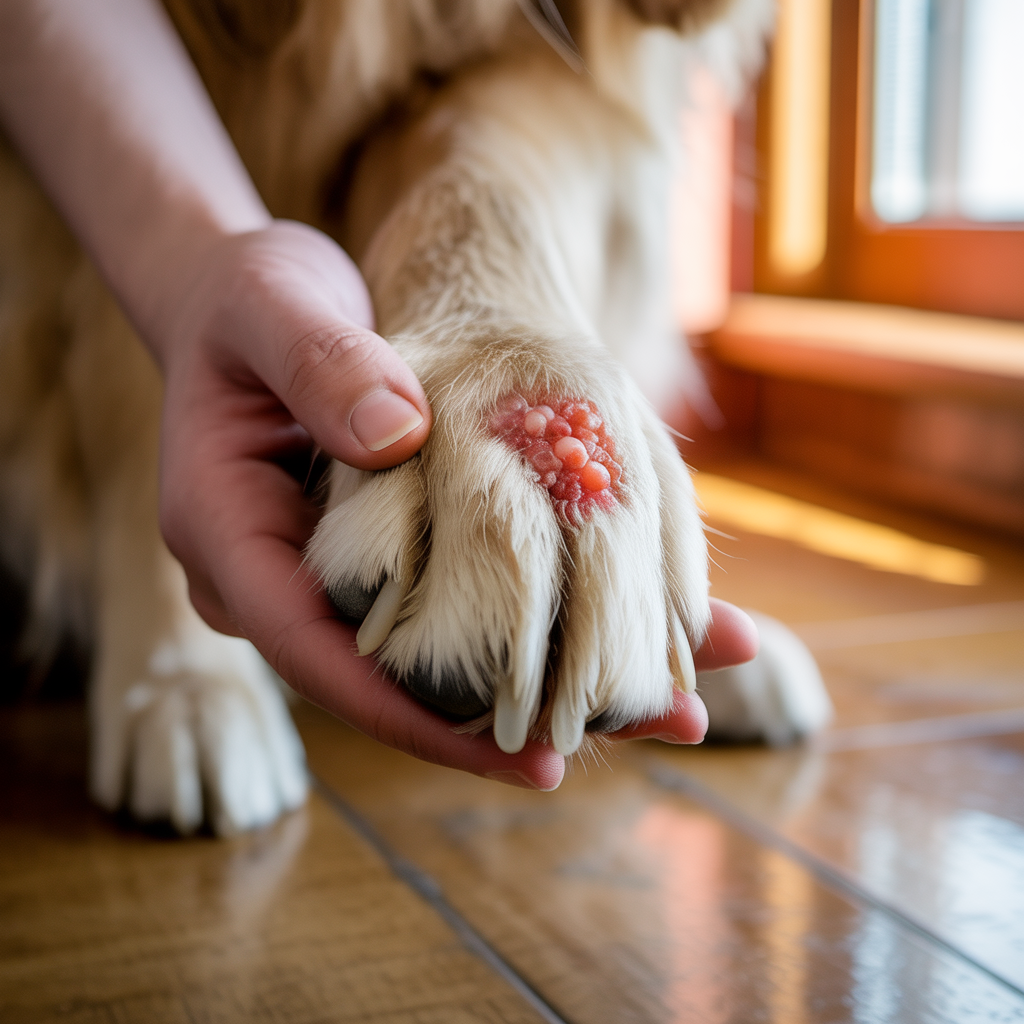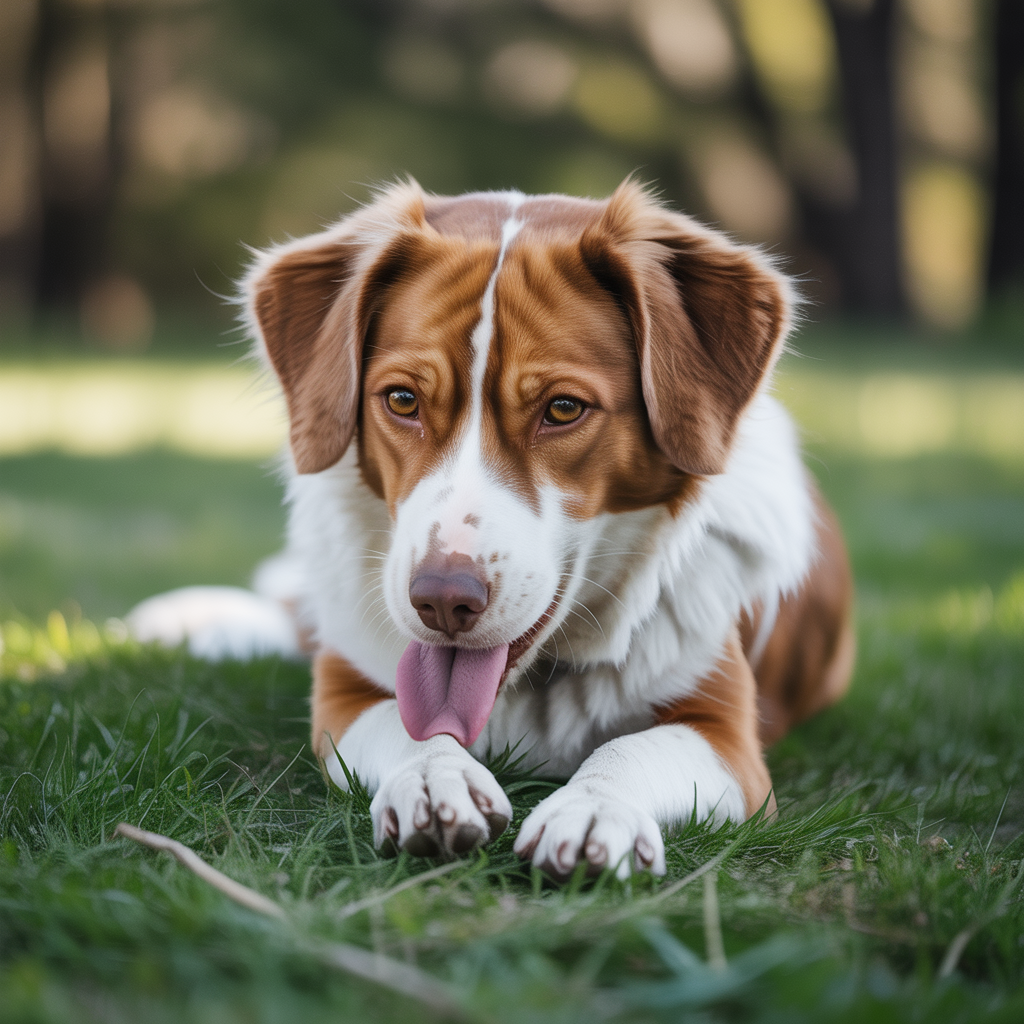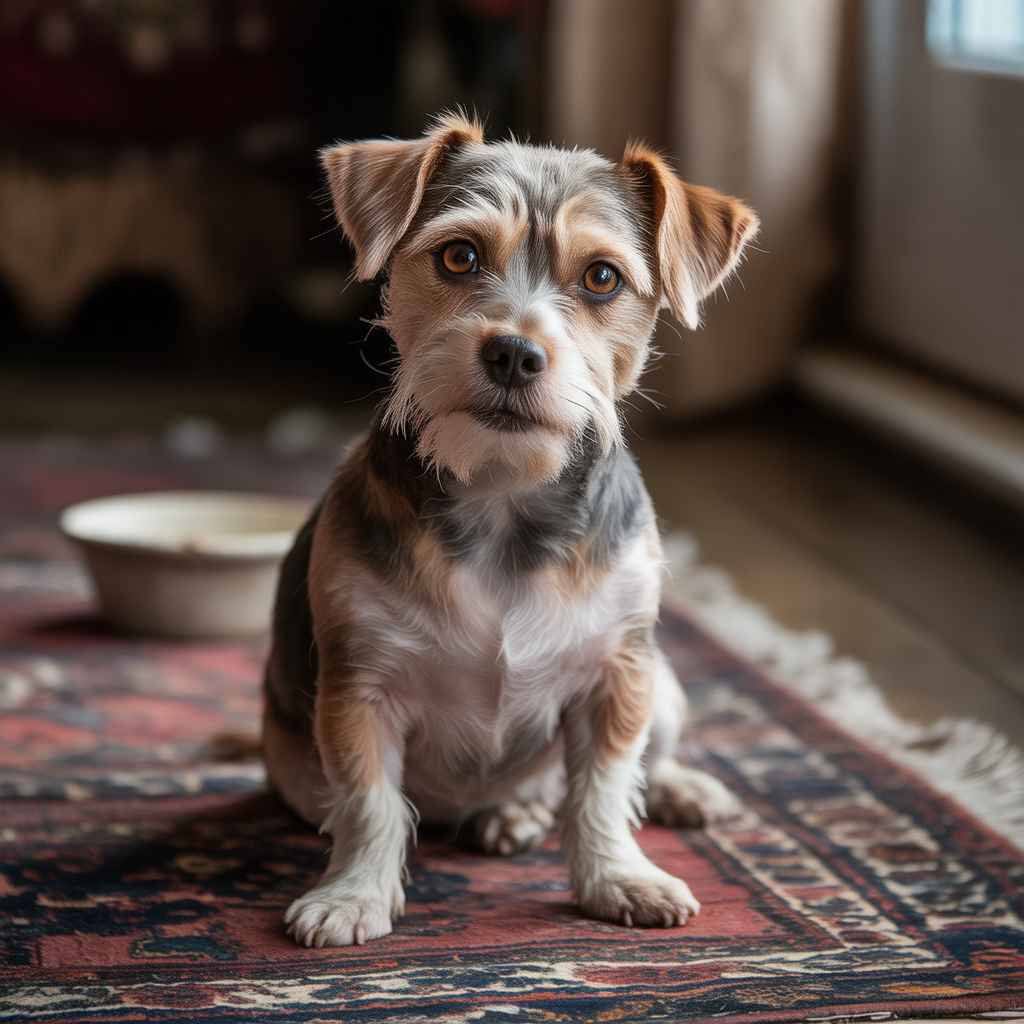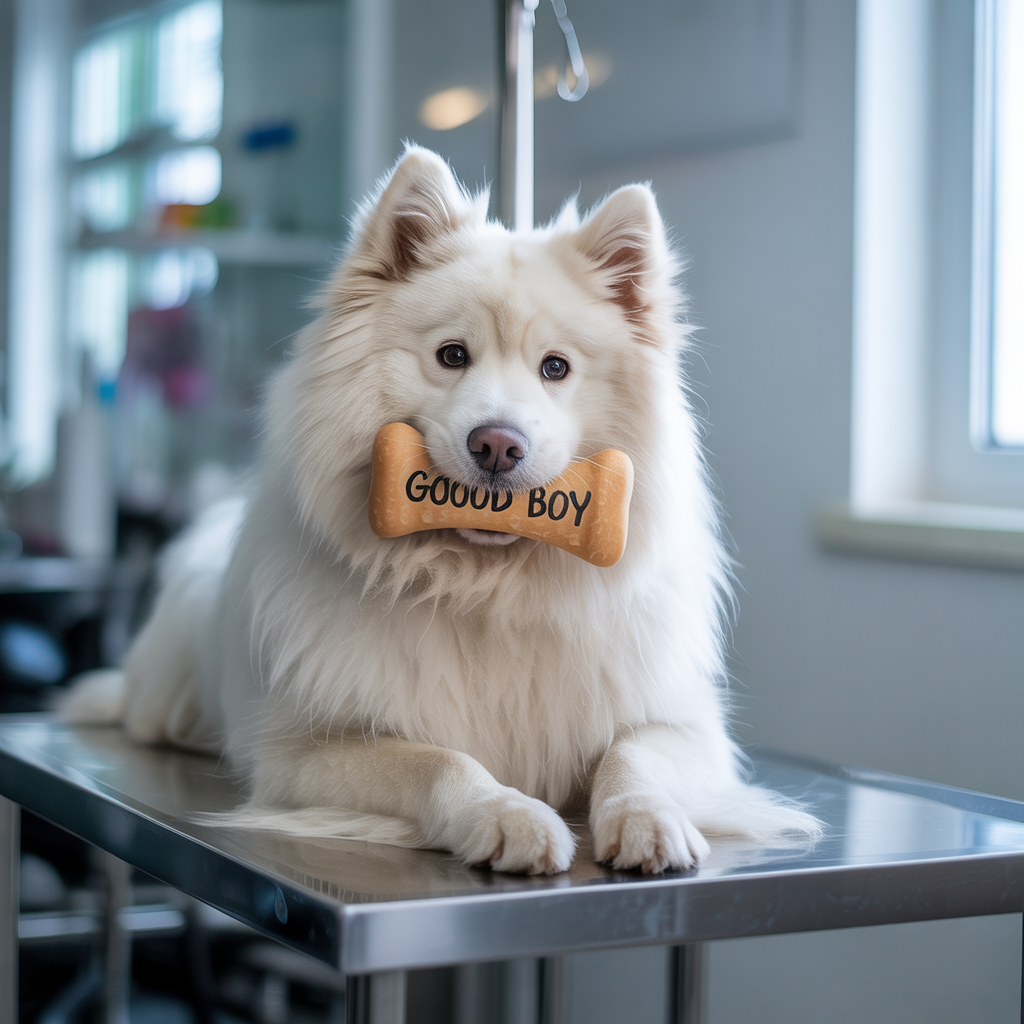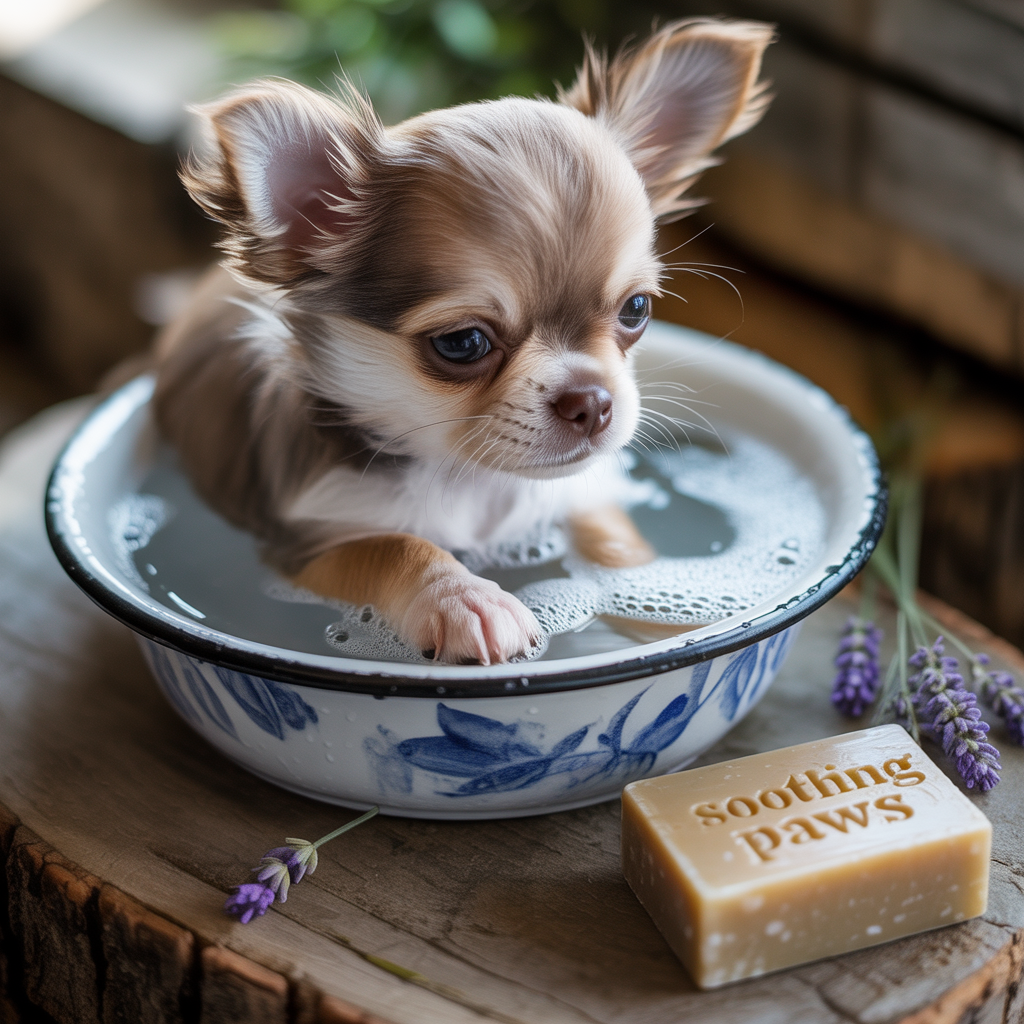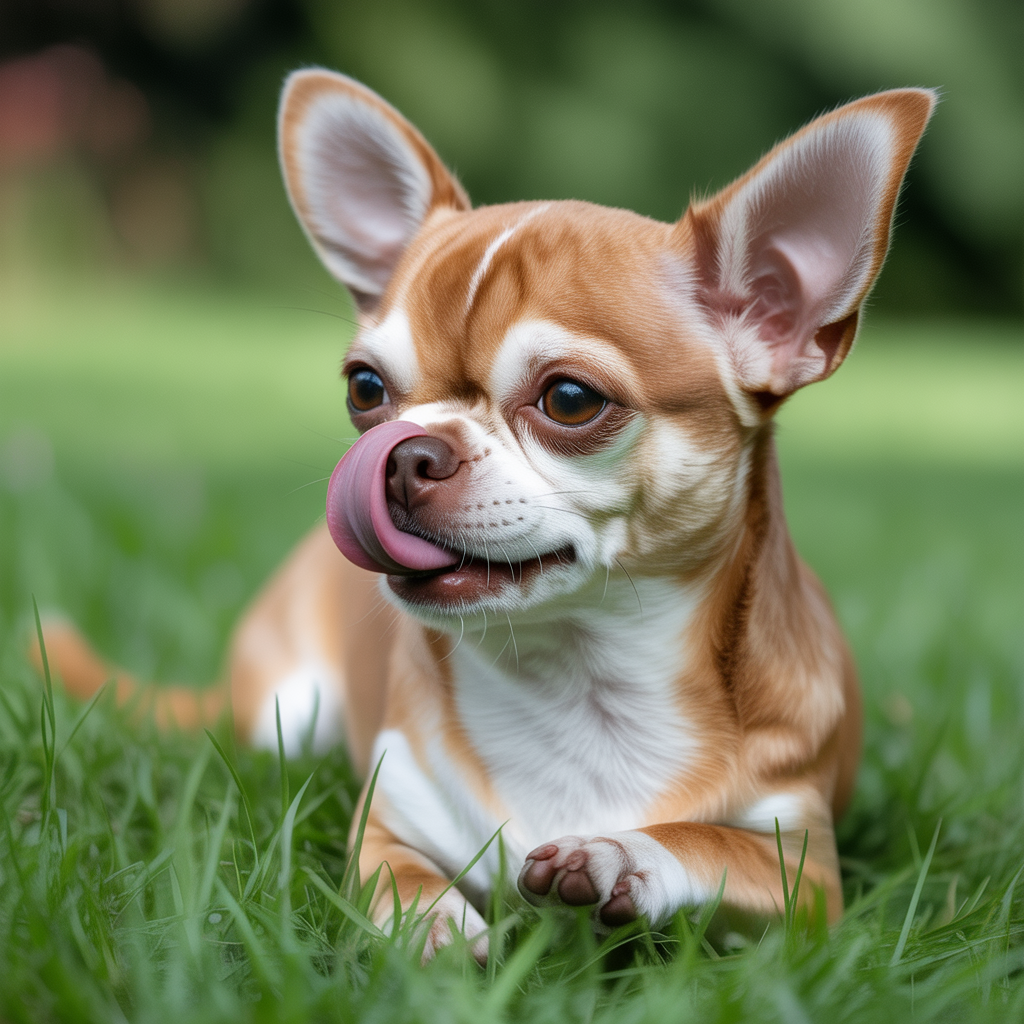Why Do Dogs Lick Their Paws? 7 Surprising Reasons Revealed
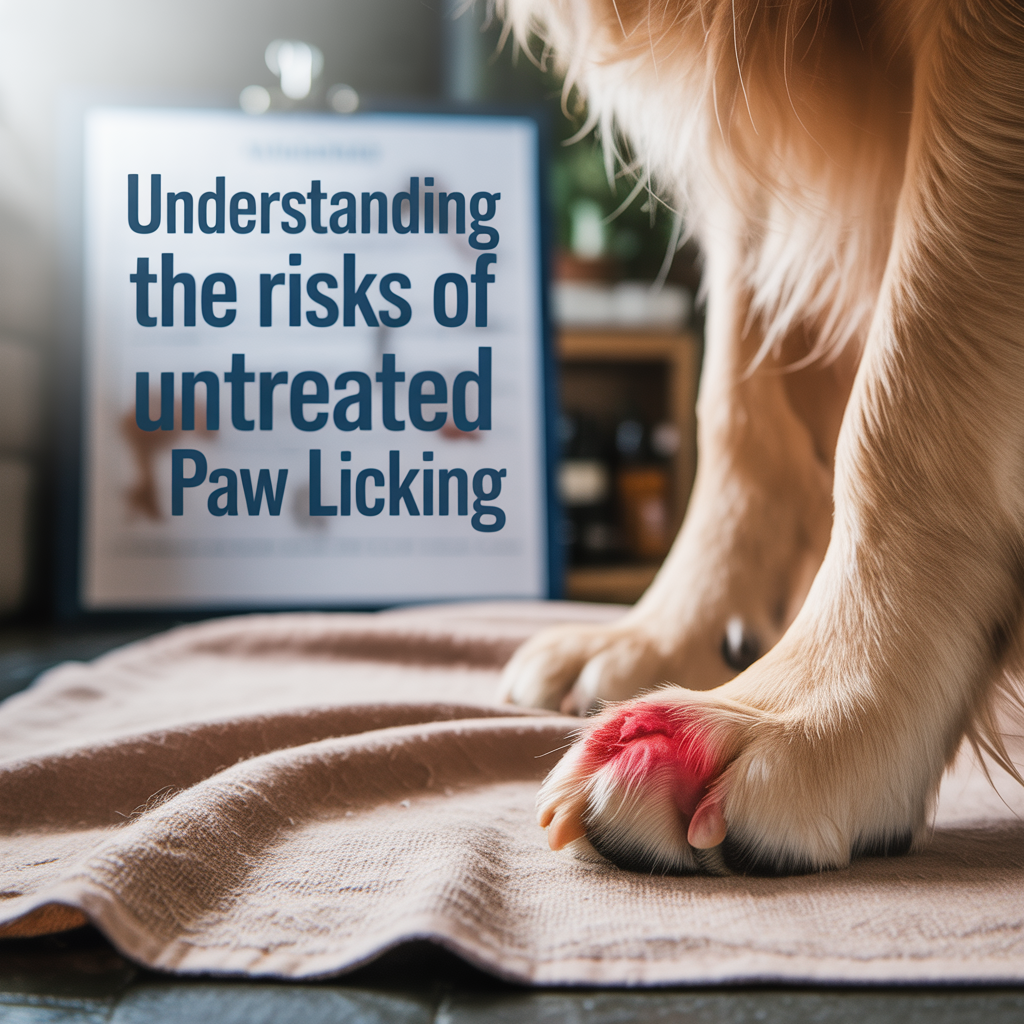
Why Do Dogs Lick Their Paws? 7 Surprising Reasons Revealed
In this ultimate guide to canine paw obsessions, we’ll dive into the fascinating (and sometimes surprising) reasons behind why dogs lick their paws, how to tell when casual grooming has crossed into problematic territory, and practical solutions to help your four-legged friend find relief. Think of it as your roadmap from “What’s wrong, buddy?” to “Problem solved!”
Understanding Normal vs. Excessive Paw Licking in Dogs
Let’s face it—dogs do plenty of things that make us raise an eyebrow. Paw licking is actually one of their more normal behaviors! Just like how we wash our hands after getting dirty, dogs instinctively clean their paws after outdoor adventures. It’s basic canine hygiene 101.
However, there’s a Grand Canyon-sized difference between normal grooming and problematic paw licking. As Dr. Valentina Henao, veterinarian and medical director at Veterinary Emergency Group in Miami, puts it: “If your dog is licking and chewing their paws excessively to the point where they’re causing themselves harm, then it’s time for a closer look at what might be going on.” (Think of it as the difference between washing your hands and scrubbing them raw—one is healthy, the other needs attention!)
Signs Your Dog’s Paw Licking Has Gone From Cute to Concerning:
- Your dog continues licking despite your best “Hey, stop that!” distractions
- The licking focuses on one particular paw like it’s the last popsicle on a hot summer day
- You notice redness, swelling, or hair loss (bald spots are for fashion-forward humans, not dog paws)
- Your pup walks like they’re crossing hot coals or avoiding stepping on LEGO bricks
- The paws smell funky (and not in a “just rolled in something interesting” way)
- The fur around the paws looks like it’s been dyed a rusty red color
- The licking interferes with important dog activities like eating, playing, or judging your Netflix choices
If you’ve nodded your head to any of these, it’s time to play pet detective. Let’s explore the seven most common reasons why dogs lick their paws excessively—no magnifying glass required!
1. Allergies: When Your Dog’s Immune System Goes Rogue
Allergies are the number one reason why dogs constantly lick their paws—they’re essentially the canine equivalent of humans with hay fever, except instead of sneezing, dogs get itchy paws. Talk about an evolutionary design flaw! Just like humans who can’t resist scratching a mosquito bite, dogs can’t help but lick their irritated paws in a desperate attempt to find relief.
Environmental Allergies: When the Great Outdoors Becomes the Great Itch-doors
Environmental allergies, also known as atopic dermatitis, are particularly common in dogs. According to the American Kennel Club, these allergies typically develop when dogs are between 1-5 years old and can be triggered by:
- Pollen from trees, grasses, and weeds (basically, nature’s confetti)
- Mold spores (the uninvited houseguests that never leave)
- Dust mites (microscopic roommates you never knew you had)
- Household cleaning products (the price of a clean home)
- Certain fabrics or materials (yes, even dogs can be fashion critics)
Dr. Kate Mornement, an Applied Animal Behaviourist with a PhD in Companion Animal Behaviour, explains: “Dogs with allergies to molds and pollens routinely lick their paws after a stroll in the grass, particularly in the spring and summer.” It’s like they’re bringing home souvenirs from their walk—except instead of t-shirts, they’re collecting allergens!
If your dog’s paw licking seems to worsen during certain seasons, environmental allergies are likely the culprit. This seasonal pattern is similar to how humans suddenly become tissue-hoarding, eye-rubbing messes during pollen season.
Food Allergies: When Dinner Fights Back
Food allergies can also cause significant paw irritation. Common food allergens for dogs include:
- Beef (sorry, burger lovers)
- Chicken (yes, even that “all-natural” premium stuff)
- Dairy products (no cheese parties for these pups)
- Wheat (gluten-free isn’t just for humans anymore)
- Soy (tofu is divisive even in the dog world)
- Eggs (breakfast betrayal)
Unlike environmental allergies, food allergies typically develop when dogs are still puppies or under a year of age. If your dog only displays excessive paw licking following mealtimes or after eating certain foods—like they’re sending a restaurant complaint directly to the chef—a food allergy might be the cause.
According to a study published in the Journal of Veterinary Dermatology, approximately 10% of all allergic skin disease in dogs is caused by food allergies. For more information on identifying and managing food allergies in your pet, check out our detailed guide on common food allergies in dogs.
How to Address Allergy-Related Paw Licking:
- Consult your veterinarian for proper allergy testing and diagnosis (Dr. Google means well but lacks a medical license)
- Consider an elimination diet under veterinary supervision to identify food triggers (it’s like CSI: Kitchen Edition)
- Wipe your dog’s paws with a damp cloth after walks to remove allergens (a paw-dicure, if you will)
- Use medicated shampoos recommended by your vet to soothe irritated skin
- Ask about prescription medications like antihistamines, Apoquel, or Atopica for severe cases
“Allergies can cause a reaction almost anywhere on the body, including infections of the skin and paws, hot spots, and ear infections,” notes Dr. Henao. Working with your veterinarian to identify and manage specific allergens is crucial for long-term relief. The Merck Veterinary Manual offers excellent resources on managing canine allergies.
2. Injuries and Pain: When Licking Is DIY First Aid
Dogs often lick injured areas as a natural response to pain or discomfort—it’s their version of kissing a boo-boo to make it better. If your dog suddenly starts licking one paw with the intensity of someone trying to get the last bit of peanut butter from the jar, it could indicate an injury or foreign object lodged in the paw pad.
Common Paw Injuries That Trigger Licking:
- Cuts or abrasions from walking on rough surfaces (sidewalks: 1, paw pads: 0)
- Foreign objects like thorns, glass, or small rocks embedded between paw pads (urban paw landmines)
- Broken or torn nails that cause pain with each step (the canine equivalent of a hangnail, but worse)
- Burns from hot pavement or chemical irritants (summer sidewalks: secretly lava)
- Insect stings or bites causing localized swelling and pain (tiny creatures, big problems)
- Fractures or sprains in the paw or leg (dogs don’t get sick days)
Here’s something fascinating—dogs may also lick their paws in response to pain elsewhere in their body. “Even if the pain is somewhere else in their body, some dogs will try to deal with it by licking a front paw continuously,” explains Dr. Jerry Klein, Chief Veterinarian at the American Kennel Club.
This referred pain response is similar to how humans might experience arm pain during a heart attack. The brain sometimes misinterprets the source of pain, leading to seemingly unrelated symptoms. Learn more about how dogs communicate pain in our article on Trending Pet Products for 2025 and 2026: Top 11 Essentials
Arthritis and Joint Pain: The Silent Paw-Tormentor
Older dogs frequently develop arthritis, which can affect not just large joints like hips and legs, but also the small joints in their toes. This progressive disease occurs when joint cartilage breaks down, leading to pain, inflammation, and difficulty using the affected paws or limbs.
A 2022 study published in Veterinary Medicine and Science found that approximately 20% of dogs over the age of 7 show clinical signs of arthritis, with many using paw licking as a self-soothing mechanism for joint pain. It’s their way of saying, “These joints ain’t what they used to be!”
How to Address Injury-Related Paw Licking:
- Carefully examine your dog’s paws for visible injuries, foreign objects, or swelling (channel your inner Sherlock Holmes)
- Clean minor wounds with a pet-safe antiseptic solution (not the burning kind—your dog won’t appreciate that plot twist)
- Use dog booties to protect injured paws during the healing process (fashion and function!)
- Apply a cold compress for acute injuries to reduce swelling (the “bag of frozen peas” trick works for dogs too)
- Consult your veterinarian if the injury appears serious or if your dog shows signs of significant pain
For arthritis-related licking, your veterinarian might recommend:
- Weight management to reduce pressure on joints (less fluff = less pain)
- Low-impact exercise to maintain mobility (swimming: the joint-friendly workout)
- Anti-inflammatory medications (the pharmaceutical cavalry)
- Joint supplements containing glucosamine and chondroitin (the joint juice)
Remember, if your dog is reluctant to let you examine the affected paw or shows signs of severe pain, seek veterinary care immediately. The American Veterinary Medical Association offers excellent first aid guidance for pet emergencies. For more tips on caring for an injured pet, visit our guide on first aid for dogs.
3. Infections: When Bacteria and Yeast Throw a Paw Party
[Dog paw infection]
The warm, moist environment between a dog’s toes creates the perfect breeding ground for bacteria and yeast—think of it as a microscopic spa resort where these unwelcome guests check in but don’t check out. These microorganisms can cause infections that lead to intense itching, prompting your dog to lick excessively.
Bacterial Infections: The Uninvited Guests
Bacterial infections often develop secondary to allergies or injuries. When dogs lick their paws due to these primary issues, the moisture creates conditions where bacteria thrive, leading to a cycle of infection and more licking. It’s like a vicious circle that goes: itch → lick → more bacteria → more itch → more lick. Someone needs to break up this party!
Signs of bacterial paw infections include:
- Redness and swelling (the paw equivalent of a “No Vacancy” sign)
- Discharge or pus (nature’s way of saying “Houston, we have a problem”)
- Strong odor (not the kind you want to bottle as “Eau de Dog”)
- Crusty or scabby skin (the skin’s DIY repair attempt)
- Pain when the paw is touched (resulting in the classic “don’t even think about it” look)
According to the Veterinary Dermatology Journal, Staphylococcus pseudintermedius is the most common bacteria involved in canine skin infections, including those affecting the paws. That’s a fancy name for a not-so-fancy problem!
Yeast Infections: The Fungus Among Us
Yeast infections are particularly common in dogs with allergies or those with naturally moist skin folds. Malassezia, the most common yeast that affects dogs, thrives in warm, humid environments—basically, your dog’s paws are a yeast paradise.
Signs of a yeast infection in your dog’s paws include:
- Rusty-red fur discoloration (especially in light-colored dogs)
- Greasy skin (like they stepped in butter, but worse)
- Sweet or musty odor (think corn chips or old socks—yes, really!)
- Thickened skin that may appear elephant-like (not the cute kind)
- Intense itchiness (the “I can’t stop licking” kind)
Breeds with deep skin folds or ears, such as Basset Hounds, Cocker Spaniels, and Bulldogs, are particularly susceptible to yeast infections. It’s like they won a genetic lottery nobody wanted to enter.
How to Address Infection-Related Paw Licking:
- Visit your veterinarian for proper diagnosis and treatment (this is not a DIY project)
- Use prescribed antibiotics for bacterial infections (follow the full course—no skipping!)
- Apply antifungal medications for yeast infections (fungus fighters to the rescue)
- Keep paws clean and dry to prevent recurrence (moisture is the enemy)
- Consider medicated shampoos or soaks as recommended by your vet (spa day with benefits)
“Paw licking can lead to bacterial infections of the paws called pododermatitis,” warns Dr. Henao. “This condition can be painful and lead to infections that can be hard to treat.” Catching the issue early can lead to a simpler solution. The Cornell University College of Veterinary Medicine offers excellent resources on pododermatitis in dogs.
4. Parasites: Tiny Invaders Causing Major Irritation
External parasites are another common reason why dogs lick their paws excessively. Fleas, ticks, mites, and other parasites can cause intense itching and discomfort, leading to persistent paw licking. These tiny troublemakers are essentially the uninvited houseguests of the pet world—small in size but huge in annoyance factor!
Fleas and Flea Allergy Dermatitis: The Microscopic Vampires
Fleas are the most common external parasite affecting dogs. While any dog can experience discomfort from flea bites, some dogs develop flea allergy dermatitis (FAD)—an allergic reaction to proteins in flea saliva. It’s like being allergic to mosquito bites, but on a whole other level of itchiness.
According to the Cornell University College of Veterinary Medicine, just one flea bite can cause intense itching for up to a week in dogs with FAD. This explains why some dogs continue licking their paws even after you’ve eliminated most of the fleas. Talk about holding a grudge!
Signs of flea infestation include:
- Visible fleas or flea dirt (small black specks) in the coat (the evidence doesn’t lie)
- Excessive scratching, biting, or licking, particularly around the tail base and paws
- Red, irritated skin (the aftermath of the flea feast)
- Hair loss (the collateral damage)
- Restlessness (because who can relax when they’re being eaten alive?)
Mites and Mange: The Microscopic Miners
Several types of mites can affect dogs, with sarcoptic mange (caused by Sarcoptes scabiei) and demodectic mange (caused by Demodex canis) being the most common. These microscopic parasites burrow into the skin, causing intense itching that often leads to paw licking. They’re basically tiny excavators using your dog’s skin as their construction site.
Sarcoptic mange is highly contagious and can even be transmitted to humans (sharing is not always caring.
How to Address Parasite-Related Paw Licking:
- Implement a year-round parasite prevention program recommended by your veterinarian (prevention is the best medicine)
- Regularly check your dog for signs of parasites, especially after outdoor activities (be a parasite detective)
- Keep your home environment clean by washing pet bedding frequently and vacuuming regularly (clean house = fewer bugs)
- Treat all pets in the household simultaneously to prevent reinfestation (no parasite ping-pong)
- Consider environmental treatments for severe infestations (sometimes you need to bring in the big guns)
The Centers for Disease Control and Prevention (CDC) offers excellent resources on flea control and prevention. For a comprehensive approach to parasite control, consult our guide on year-round parasite prevention for pets.
5. Anxiety and Stress: When Dogs Need a Therapist’s Couch
Just like humans might bite their nails when nervous (or scroll mindlessly through social media), dogs sometimes lick their paws as a self-soothing mechanism when experiencing anxiety or stress. This behavior releases endorphins that temporarily make your dog feel better, potentially leading to a compulsive habit. It’s essentially their version of stress-eating ice cream straight from the container!
Common Anxiety Triggers in Dogs:
- Separation anxiety when left alone (the “you complete me” syndrome)
- Environmental changes like moving to a new home (dogs hate packing boxes almost as much as cats do)
- Loud noises such as thunderstorms or fireworks (the sky is falling!)
- New family members (human or animal) (who invited THEM to the party?)
- Past trauma or negative experiences (dogs have long memories for the bad stuff)
Dr. Kate Mornement explains: “Stress and anxiety can cause dogs to lick their paws excessively. In this context, the behavior is self-calming as it can provide temporary relief or distraction from stress and anxiety, much like fingernail biting does for people.” Or like how some of us “stress clean” our houses at 2 AM!
A 2021 study in the Journal of Veterinary Behavior found that approximately 14% of dogs exhibit some form of anxiety-related behavior, with paw licking being among the most common manifestations. This statistic highlights how prevalent anxiety-related behaviors are in our canine companions. They’re just trying to cope in a world full of vacuum cleaners and mail carriers!
How to Address Anxiety-Related Paw Licking:
- Identify and minimize stressors in your dog’s environment (be a canine stress detective)
- Establish consistent routines to provide security (dogs love predictability almost as much as dinner time)
- Use calming aids like ThunderShirts or pheromone diffusers (anxiety fashion and aromatherapy for dogs)
- Provide mental stimulation through puzzle toys and training (keep that doggy brain busy)
- Consider behavior modification techniques with the help of a professional dog trainer or animal behaviorist (sometimes you need to call in the experts)
- Discuss anti-anxiety medications with your veterinarian for severe cases (pharmaceutical chill pills)
For dogs with separation anxiety, gradually increasing alone time and providing engaging toys can help reduce stress-related paw licking. In severe cases, your veterinarian might recommend working with a certified animal behaviorist. The American College of Veterinary Behaviorists can help you find a qualified professional.
For more strategies to help an anxious pet, check out our comprehensive guide on managing anxiety in dogs.
6. Boredom and Habit: When Licking Becomes the Dog Version of Doomscrolling
Dogs are intelligent animals that need mental and physical stimulation. Without adequate exercise and enrichment, they may develop repetitive behaviors like excessive paw licking simply out of boredom. It’s their version of watching the same Netflix show for the fifth time because there’s “nothing else to do.”
What begins as occasional licking due to one of the causes mentioned earlier can eventually develop into a habit or compulsive behavior. This is particularly common in high-energy breeds like Border Collies, Australian Shepherds, and Terriers—breeds that were designed to work all day but now find themselves with a lot of downtime and Netflix recommendations.
Signs That Paw Licking Has Become a Habit:
- The behavior continues even after the original cause has been addressed (old habits die hard)
- Your dog licks in patterns or at specific times of day (it’s on their internal schedule)
- The licking intensifies when your dog is under-stimulated (boredom = lick o’clock)
- Your dog seems to enter a “trance-like” state while licking (the doggy zen zone)
Over time, compulsive licking can lead to a condition called lick granuloma or acral lick dermatitis—an open, irritated sore that develops from constant licking of the same spot. These lesions are most commonly found on the front legs, particularly around the carpal (wrist) joint. It’s like the canine equivalent of wearing a hole in your favorite jeans—except painful and medical.
According to the Journal of Small Animal Practice, once a lick granuloma forms, it creates a self-perpetuating cycle: the irritation causes the dog to lick, which further irritates the area, leading to more licking. Breaking this cycle often requires a multi-faceted approach. It’s like trying to stop biting your nails—easier said than done!
How to Address Boredom and Habitual Paw Licking:
- Increase physical exercise appropriate for your dog’s age and breed (tired dogs are good dogs)
- Provide mental stimulation through training, puzzle toys, and new experiences (doggy brain games)
- Use deterrents like bitter apple spray on the affected area after consulting your vet (the taste of regret)
- Redirect the behavior by engaging your dog in alternative activities when licking starts (distraction is your friend)
- Consider physical barriers like Elizabethan collars (cones) or special boots for severe cases (the cone of shame has a purpose)
“To deal with boredom, try taking your dog for more walks or runs,” recommends the American Kennel Club. “Increase playtime with you and with other dogs to use up more mental and physical energy.” Basically, a tired dog is less likely to redecorate your furniture or develop obsessive habits!
Google AI Mode Enhances Search with Chatbot Features
7. Dry Skin and Environmental Factors: When the World Is Out to Irritate Your Dog
Image source: Unsplash
Environmental factors can significantly impact your dog’s skin health, potentially leading to dry, irritated paws that your dog feels compelled to lick. These factors include everything from weather conditions to the cleaning products you use—basically, the world is full of potential paw irritants!
Weather Conditions: The Seasonal Paw Challenges
Extreme weather conditions can wreak havoc on your dog’s paws:
- Winter cold and ice: Cold temperatures and ice-melting chemicals can cause dryness, cracking, and chemical burns (salt is for margaritas, not paw pads)
- Summer heat: Hot pavement can burn paw pads, leading to painful blisters (the “hot potato” dance on walks is a warning sign)
- Low humidity: Dry air, especially during winter months with indoor heating, can cause skin and paw pad dryness (the static electricity season)
According to a study in the Journal of the American Veterinary Medical Association, paw pad injuries increase by approximately 30% during extreme weather conditions, highlighting the importance of seasonal paw protection. That’s a statistic no dog parent wants their pup to be part of!
Household Products: The Hidden Hazards
Many common household products contain chemicals that can irritate your dog’s sensitive paw pads:
- Floor cleaners and disinfectants (clean floors, irritated paws)
- Lawn fertilizers and pesticides (green lawn, red paws)
- Laundry detergents used on pet bedding (clean sheets, itchy feet)
- Air fresheners and scented candles (smells good to you, feels bad to them)
Even natural cleaning products can contain essential oils that may irritate your dog’s skin. For safer alternatives, check out our guide on pet-safe household products.
How to Address Environment-Related Paw Licking:
- Use protective booties in extreme weather conditions (dog fashion that’s actually functional)
- Apply paw balm or wax before outdoor activities to create a protective barrier (paw spa treatment)
- Rinse paws after walks to remove potential irritants (the doggy car wash)
- Switch to pet-safe household products to minimize chemical exposure (kinder cleaning)
- Use a humidifier during dry winter months to maintain healthy skin moisture levels (spa vibes for everyone)
The ASPCA offers excellent resources on seasonal paw care for dogs. By addressing these environmental factors, you can significantly reduce your dog’s discomfort and the resulting paw licking behavior.
When to See a Veterinarian About Your Dog’s Paw Licking
While occasional paw licking is normal, certain warning signs indicate it’s time to consult a professional. According to veterinary experts, you should seek veterinary care if:
- The licking is sudden and intense (like they just discovered their paws exist)
- You notice redness, swelling, or discharge (the unholy trinity of infection signs)
- Your dog is limping or favoring a paw (the canine equivalent of hopping on one foot)
- The paw has an abnormal odor (if YOU can smell it, it’s definitely not good)
- There’s visible hair loss or skin damage (bald spots belong on middle-aged men, not dog paws)
- Your dog seems to be in pain (those puppy eyes don’t lie)
- The behavior persists despite home remedies (when DIY fails, call the pros)
Early intervention is key to preventing complications. “The sooner you can address the problem and illuminate the cause, the better,” advises the American Kennel Club.
During your veterinary visit, be prepared to answer questions about:
- When you first noticed the excessive licking (the origin story)
- Whether it affects one paw or multiple paws (the spread factor)
- Any changes in your dog’s environment or routine (the plot twists)
- Recent activities that might have exposed your dog to irritants (the suspect list)
- Other symptoms you’ve observed (the supporting evidence)
Your veterinarian may recommend diagnostic tests such as skin scrapings, allergy testing, or even radiographs to determine the underlying cause of your dog’s paw licking.
Effective Home Remedies for Dog Paw Licking
While veterinary care is essential for diagnosing and treating the underlying cause of excessive paw licking, several home remedies can provide relief in the meantime. Think of these as first aid while you wait for the professionals—like putting a bandaid on before heading to the doctor!
1. Paw Soaks: The DIY Spa Treatment
A gentle soak can help soothe irritated paws and remove allergens:
- Mix 1 cup of warm water with 1 tablespoon of Epsom salt (the doggy version of a relaxing bath)
- Soak the affected paw for 5-10 minutes (good luck keeping your dog still!)
- Gently pat dry, ensuring no moisture remains between toes (the drying dance)
For dogs with yeast infections, a diluted apple cider vinegar solution (1 part vinegar to 2 parts water) can help create an unfavorable environment for yeast growth. However, never use this solution on open wounds or raw skin, as it will cause significant pain. Your dog won’t thank you for that surprise!
2. Protective Barriers: The Physical Intervention
To prevent your dog from accessing their paws while healing:
- Dog booties provide physical protection from environmental irritants (fashion meets function)
- Soft recovery collars or cones prevent access to paws (the cone of shame has its purpose)
- Specially designed recovery suits can cover paws without restricting movement (doggy onesies for the win)
According to a survey by the American Pet Products Association, approximately 25% of dog owners have used protective boots for their pets, primarily for weather protection and injury prevention. That’s a lot of dogs doing the “booties shuffle”!
3. Environmental Management: Creating a Paw-Friendly World
Minimize exposure to potential allergens:
- Wipe paws with a damp cloth after walks (the doggy doormat)
- Use pet-safe floor cleaners (recommended by the Environmental Working Group)
- Wash bedding regularly in hypoallergenic detergent (clean sheets = happy paws)
- Consider an air purifier to reduce airborne allergens (fresh air for everyone)
4. Dietary Support: Beauty From Within
Support skin health through nutrition:
- Omega-3 fatty acid supplements can reduce inflammation (fish oil isn’t just for humans)
- Probiotics may help balance the immune system (good gut = less scratching)
- Ensure your dog drinks plenty of water to maintain skin hydration (hydration is key)
A 2023 study in the Journal of Veterinary Dermatology found that dogs receiving omega-3 fatty acid supplements showed a 30% reduction in allergy-related symptoms, including paw licking, compared to a control group. Science says fish oil works!
Remember, these home remedies should complement, not replace, professional veterinary care for persistent paw licking.
Preventing Excessive Paw Licking in Dogs
Prevention is always better than cure—or as dog owners might say, it’s easier to prevent the problem than to stop a determined dog mid-lick! Here are some strategies to help prevent your dog from developing problematic paw-licking habits:
Regular Paw Maintenance: The Weekly Check-Up
- Inspect paws weekly for signs of injury, foreign objects, or irritation (be a paw detective)
- Trim nails regularly to prevent overgrowth and related discomfort (the clickety-clack on the floor is too long)
- Trim excess hair between paw pads in long-haired breeds (no fur mittens)
- Clean paws after walks, especially in areas with potential allergens or irritants (the post-walk wipe-down)
According to the American Veterinary Medical Association, regular paw maintenance can prevent up to 60% of common paw problems that lead to excessive licking. That’s a lot of prevention for a little effort!
Environmental Considerations: Paw-Proofing the World
- Avoid walking on extremely hot or cold surfaces (if you wouldn’t walk barefoot, neither should they)
- Be cautious with lawn chemicals and de-icing products (green lawn ≠ happy paws)
- Provide appropriate footwear for harsh weather conditions (yes, dog boots look silly, but they work)
- Create safe walking paths free from thorns, glass, and other hazards (paw patrol, on a roll!)
A simple test for pavement heat: place the back of your hand on the pavement for 7 seconds. If it’s too hot for your hand, it’s too hot for your dog’s paws. No thermometer needed!
Mental and Physical Stimulation: A Tired Dog Is a Good Dog
- Ensure adequate daily exercise appropriate for your dog’s breed and age (run them, don’t ruin them)
- Provide interactive toys to prevent boredom (mental gymnastics for canines)
- Establish a consistent routine to reduce anxiety (dogs love knowing what comes next)
- Consider doggy daycare or playdates for social stimulation (dog friends are the best friends)
The Association of Professional Dog Trainers offers excellent resources on appropriate exercise and mental stimulation for different breeds.
Dietary Management: You Are What You Eat
- Feed a high-quality, balanced diet appropriate for your dog’s age and health needs (premium fuel for your furry engine)
- Consider food allergies when selecting treats and meals (one dog’s treat is another dog’s trigger)
- Maintain proper hydration to support overall skin health (water is the elixir of life)
- Discuss supplements like omega-3 fatty acids with your veterinarian (fish oil: not just for humans)
By implementing these preventive measures, you can significantly reduce the likelihood of your dog developing problematic paw-licking behaviors. Think of it as paw insurance!
Understanding the Risks of Untreated Paw Licking
[Lick granuloma]
Image source: Unsplash
Left untreated, excessive paw licking can lead to serious complications—it’s like ignoring a check engine light on your car, except the car is your beloved furry friend! Here’s what could happen if you hit the snooze button on this canine problem:
Physical Complications: The Body Breakdown
- Secondary infections that may require antibiotics (when one problem invites its friends over)
- Lick granulomas (chronic, non-healing wounds that make veterinarians sigh deeply)
- Permanent hair loss in affected areas (bald spots that won’t be fixed with Rogaine)
- Tissue damage that may require surgical intervention (when licking leads to the operating room)
- Chronic pain affecting quality of life (nobody wants a perpetually uncomfortable pup)
According to a study in the Journal of Veterinary Dermatology, approximately 30% of untreated cases of excessive paw licking develop into lick granulomas, which can be extremely difficult to resolve once established. It’s like trying to fix a pothole that’s turned into the Grand Canyon!
Behavioral Complications: The Mind Matters
- Development of obsessive-compulsive disorders (when a habit becomes a need)
- Increased anxiety and stress (a vicious cycle of lick → stress → lick more)
- Sleep disturbances due to constant licking (insomnia isn’t just for humans)
- Decreased interest in normal activities (when licking replaces playing)
- Potential aggression when attempts are made to stop the behavior (the “don’t touch my paw” growl)
“The moisture of constant foot licking can cause a secondary bacterial or yeast infection – causing even more itching, redness, swelling, and licking,” warns the American Kennel Club. It’s like a never-ending cycle of discomfort that makes everyone miserable—especially your dog!
For more information on recognizing and addressing behavioral problems in dogs, check out the American College of Veterinary Behaviorists for professional guidance.
Conclusion: Being Proactive About Your Dog’s Paw Health
Understanding why dogs lick their paws is the first step toward helping your furry friend find relief. Whether the cause is allergies, injuries, infections, parasites, anxiety, boredom, or environmental factors, identifying the underlying issue is crucial for effective treatment. It’s like being a detective, except the mystery directly impacts your best friend’s comfort!
Remember that occasional paw licking is normal dog behavior (like humans checking their phones), but excessive licking warrants attention (like humans checking their phones every 30 seconds). By being observant and proactive about your dog’s paw health, you can prevent minor issues from developing into serious problems that require extensive veterinary intervention.
If your dog’s paw licking seems excessive or is accompanied by other concerning symptoms, don’t hesitate to consult your veterinarian. With proper diagnosis and treatment, most dogs can overcome problematic paw licking and return to their happy, healthy selves—back to chasing squirrels and judging your Netflix choices instead of obsessing over their paws!
By working closely with your veterinary team and implementing appropriate home care strategies, you can help ensure your canine companion enjoys comfortable, itch-free paws for years to come. For more comprehensive pet care guides, browse our complete pet health section or visit the American Veterinary Medical Association for additional resources.
After all, happy paws make for a happy dog—and a happy dog makes for a happy home!
Frequently Asked Questions About Dog Paw Licking
How much paw licking is normal for dogs?
Occasional brief paw licking, especially after walks or meals, is normal grooming behavior—like humans washing their hands after dinner. However, if your dog is licking persistently for extended periods, focusing intensely on one paw, or the behavior is interfering with normal activities, it’s likely excessive and warrants investigation. Think of it as the difference between brushing your teeth (normal) and brushing them for an hour (problem).
Can I use human products to treat my dog’s irritated paws?
No, human products like lotions, creams, or medications should never be used on dogs without veterinary approval. Many human products contain ingredients that are toxic to dogs if ingested, and dogs will likely lick any substance applied to their paws. Always use products specifically formulated for canine use. The ASPCA Animal Poison Control Center lists numerous human products that can be harmful to pets.
Will my dog outgrow excessive paw licking?
Probably not. Without addressing the underlying cause, excessive paw licking typically worsens over time rather than resolves on its own. It’s like hoping a leaky pipe will fix itself—spoiler alert: it won’t! Early intervention is key to preventing the development of chronic issues like lick granulomas or compulsive behaviors. The sooner you address it, the easier it usually is to resolve.
Can certain breeds be more prone to paw licking?
Yes, some breeds are more predisposed to conditions that cause paw licking. Allergies are more common in breeds like Retrievers, Terriers, and Bulldogs (the allergy-prone club). Breeds with hair that grows between the paw pads, such as Poodles and Bichon Frises, may experience more irritation from trapped debris. High-energy breeds may develop compulsive behaviors like paw licking when under-stimulated. The American Kennel Club provides breed-specific health information that can help you understand your dog’s predispositions.
How long does it take to resolve excessive paw licking?
The timeline varies greatly depending on the underlying cause—it’s not a one-size-fits-all answer. Allergies or behavioral issues may require weeks to months of consistent management (the marathon, not the sprint). Some conditions, particularly those that have become habitual, may need ongoing management throughout your dog’s life. Patience and consistency are key—Rome wasn’t built in a day, and paw problems aren’t usually solved overnight!
Is it safe to use essential oils to treat my dog’s irritated paws?
Most essential oils are not safe for dogs, as they can be toxic if ingested, and dogs will naturally lick their paws. Additionally, some essential oils that are safe for humans can cause serious adverse reactions in dogs. The Pet Poison Helpline warns against using many common essential oils around pets. Always consult with your veterinarian before using any essential oil product on your pet. When in doubt, leave it out!
Can my dog’s diet affect paw licking behavior?
Absolutely offers excellent resources on pet nutrition and its impact on health.
Remember, when it comes to your dog’s health, being proactive is always better than reactive. Keep an eye on those paws, and don’t hesitate to seek professional help when needed. Your furry friend can’t tell you what’s wrong, but their behavior—including excessive paw licking—speaks volumes if you know what to look for!

![[Dog with allergies]](https://www.readstoday.com/wp-content/uploads/2025/05/dog-with-allergies.png)
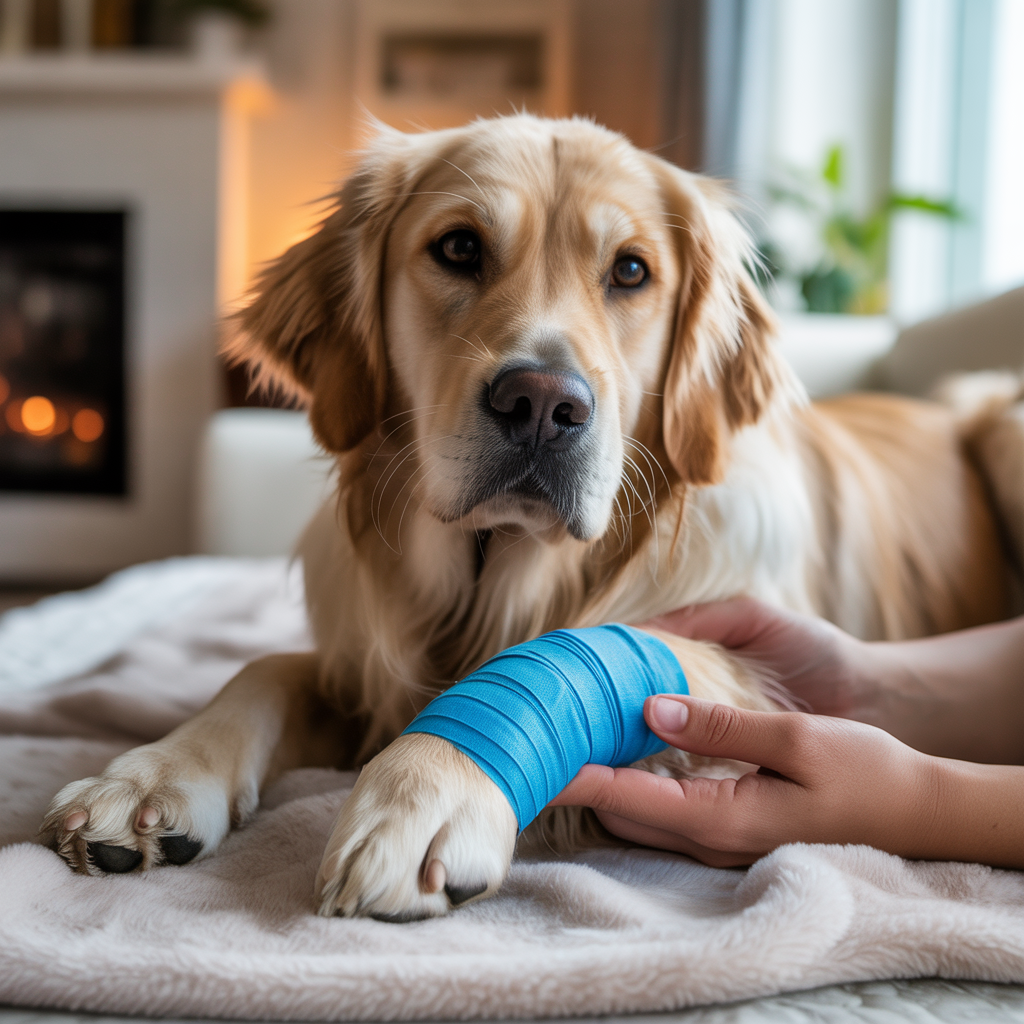
![[Dog paw infection]](https://images.unsplash.com/photo-1559190394-df5a28aab5c5?ixlib=rb-4.0.3&ixid=M3wxMjA3fDB8MHxwaG90by1wYWdlfHx8fGVufDB8fHx8fA%3D%3D&auto=format&fit=crop&w=1536&q=80)
